Debenhams: An Analysis of Business Failure
VerifiedAdded on 2023/06/13
|8
|2447
|359
AI Summary
This report analyses the reasons behind the closure of Debenhams, a UK-based retail company. It includes a company background, areas of failure, models of analysis, and recommendations for future success.
Contribute Materials
Your contribution can guide someone’s learning journey. Share your
documents today.
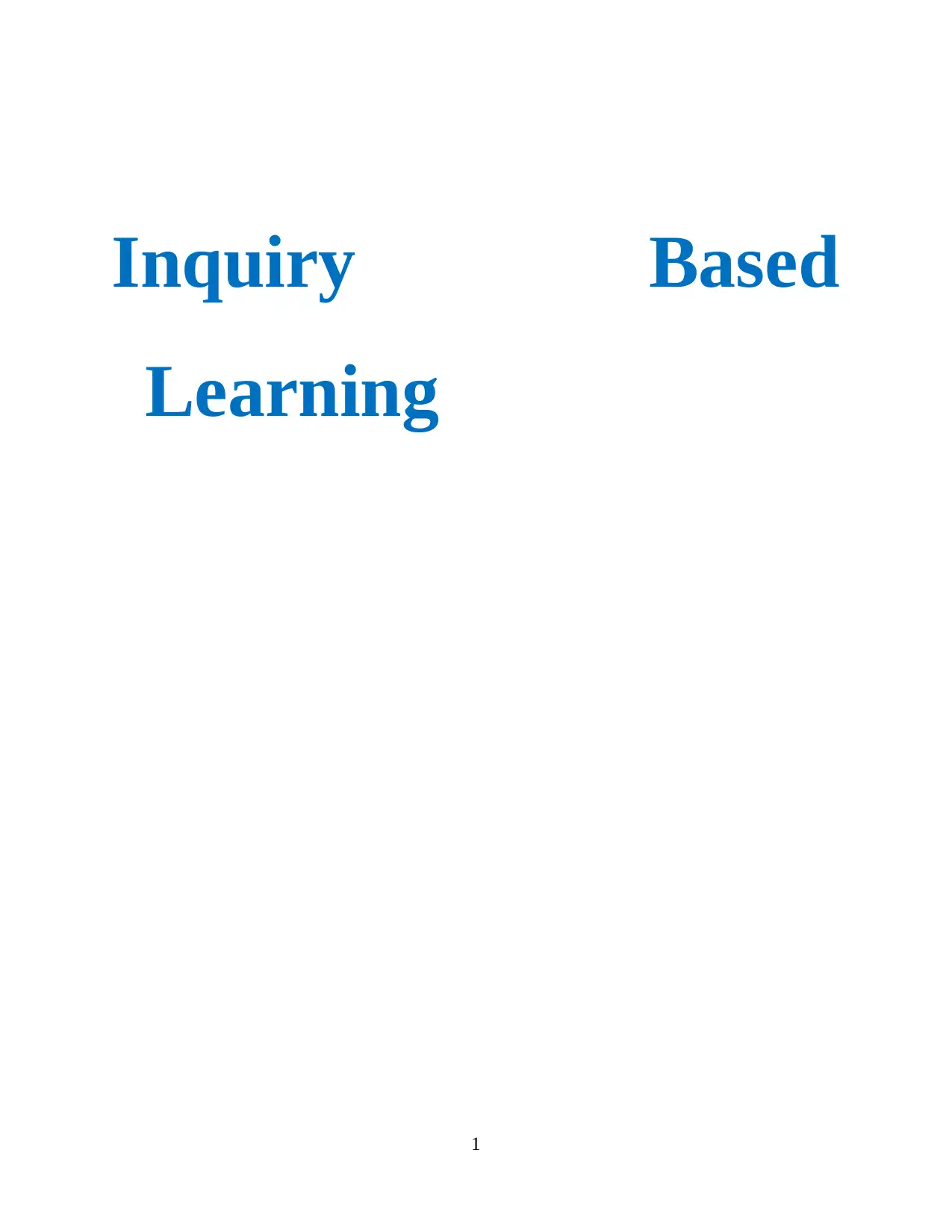
Inquiry Based
Learning
1
Learning
1
Secure Best Marks with AI Grader
Need help grading? Try our AI Grader for instant feedback on your assignments.
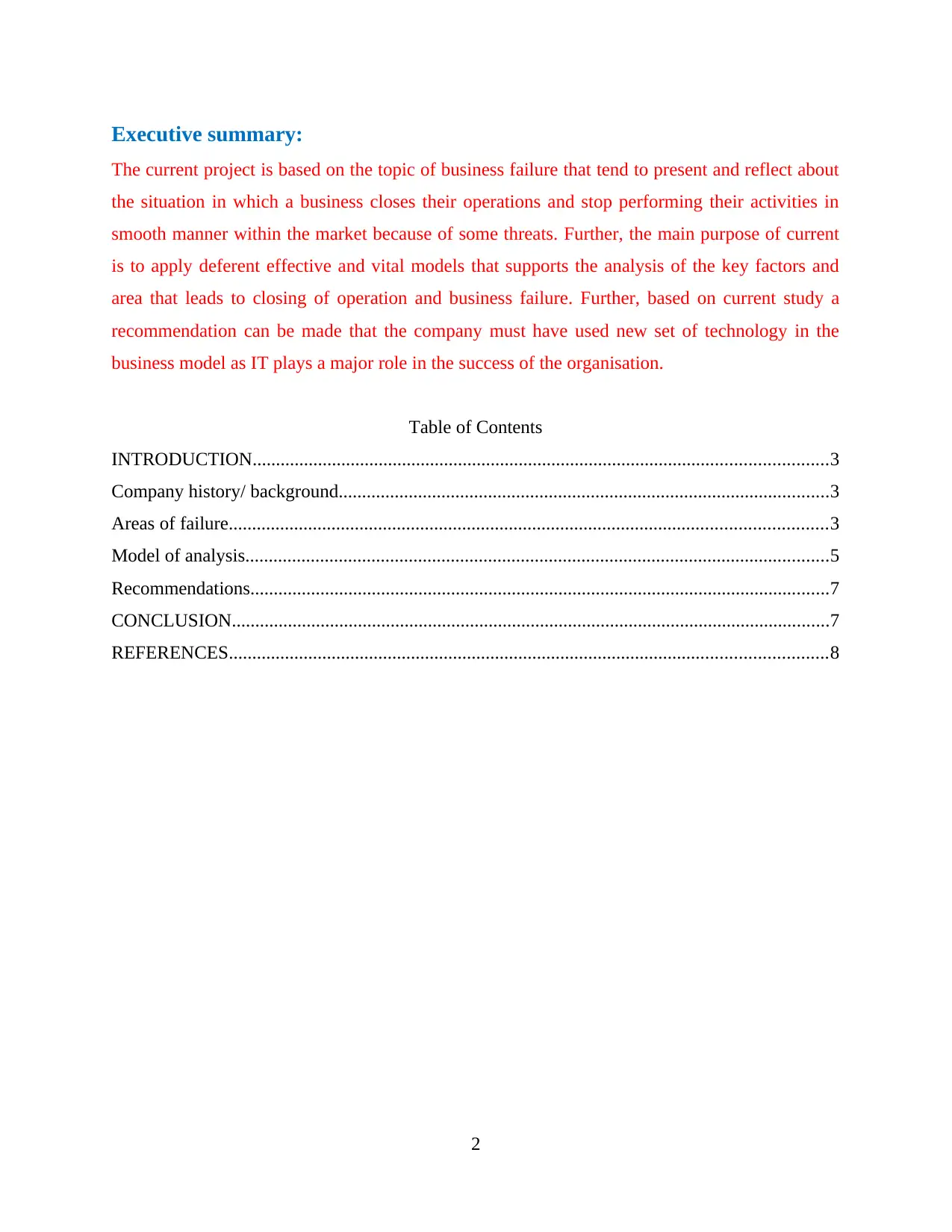
Executive summary:
The current project is based on the topic of business failure that tend to present and reflect about
the situation in which a business closes their operations and stop performing their activities in
smooth manner within the market because of some threats. Further, the main purpose of current
is to apply deferent effective and vital models that supports the analysis of the key factors and
area that leads to closing of operation and business failure. Further, based on current study a
recommendation can be made that the company must have used new set of technology in the
business model as IT plays a major role in the success of the organisation.
Table of Contents
INTRODUCTION...........................................................................................................................3
Company history/ background.........................................................................................................3
Areas of failure................................................................................................................................3
Model of analysis.............................................................................................................................5
Recommendations............................................................................................................................7
CONCLUSION................................................................................................................................7
REFERENCES................................................................................................................................8
2
The current project is based on the topic of business failure that tend to present and reflect about
the situation in which a business closes their operations and stop performing their activities in
smooth manner within the market because of some threats. Further, the main purpose of current
is to apply deferent effective and vital models that supports the analysis of the key factors and
area that leads to closing of operation and business failure. Further, based on current study a
recommendation can be made that the company must have used new set of technology in the
business model as IT plays a major role in the success of the organisation.
Table of Contents
INTRODUCTION...........................................................................................................................3
Company history/ background.........................................................................................................3
Areas of failure................................................................................................................................3
Model of analysis.............................................................................................................................5
Recommendations............................................................................................................................7
CONCLUSION................................................................................................................................7
REFERENCES................................................................................................................................8
2
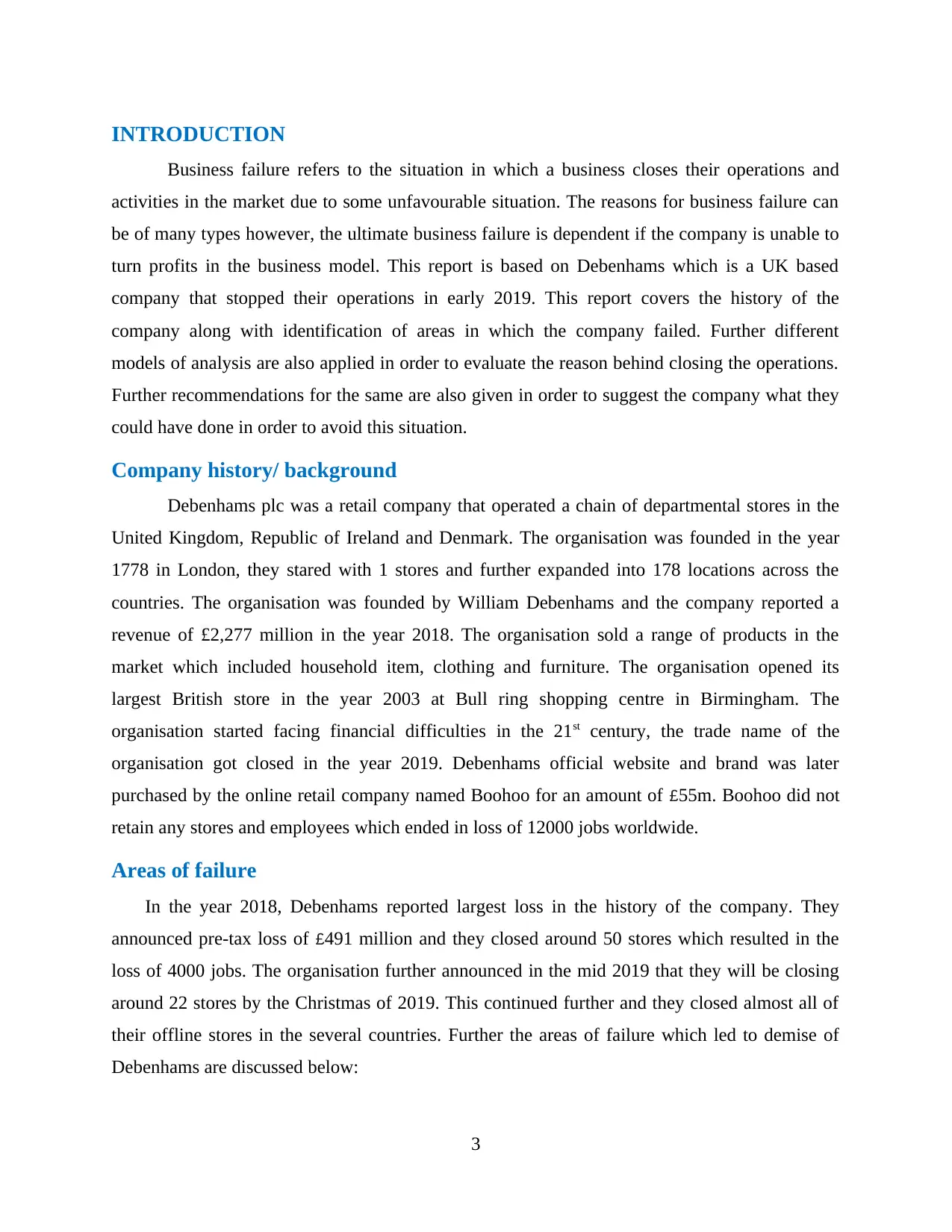
INTRODUCTION
Business failure refers to the situation in which a business closes their operations and
activities in the market due to some unfavourable situation. The reasons for business failure can
be of many types however, the ultimate business failure is dependent if the company is unable to
turn profits in the business model. This report is based on Debenhams which is a UK based
company that stopped their operations in early 2019. This report covers the history of the
company along with identification of areas in which the company failed. Further different
models of analysis are also applied in order to evaluate the reason behind closing the operations.
Further recommendations for the same are also given in order to suggest the company what they
could have done in order to avoid this situation.
Company history/ background
Debenhams plc was a retail company that operated a chain of departmental stores in the
United Kingdom, Republic of Ireland and Denmark. The organisation was founded in the year
1778 in London, they stared with 1 stores and further expanded into 178 locations across the
countries. The organisation was founded by William Debenhams and the company reported a
revenue of £2,277 million in the year 2018. The organisation sold a range of products in the
market which included household item, clothing and furniture. The organisation opened its
largest British store in the year 2003 at Bull ring shopping centre in Birmingham. The
organisation started facing financial difficulties in the 21st century, the trade name of the
organisation got closed in the year 2019. Debenhams official website and brand was later
purchased by the online retail company named Boohoo for an amount of £55m. Boohoo did not
retain any stores and employees which ended in loss of 12000 jobs worldwide.
Areas of failure
In the year 2018, Debenhams reported largest loss in the history of the company. They
announced pre-tax loss of £491 million and they closed around 50 stores which resulted in the
loss of 4000 jobs. The organisation further announced in the mid 2019 that they will be closing
around 22 stores by the Christmas of 2019. This continued further and they closed almost all of
their offline stores in the several countries. Further the areas of failure which led to demise of
Debenhams are discussed below:
3
Business failure refers to the situation in which a business closes their operations and
activities in the market due to some unfavourable situation. The reasons for business failure can
be of many types however, the ultimate business failure is dependent if the company is unable to
turn profits in the business model. This report is based on Debenhams which is a UK based
company that stopped their operations in early 2019. This report covers the history of the
company along with identification of areas in which the company failed. Further different
models of analysis are also applied in order to evaluate the reason behind closing the operations.
Further recommendations for the same are also given in order to suggest the company what they
could have done in order to avoid this situation.
Company history/ background
Debenhams plc was a retail company that operated a chain of departmental stores in the
United Kingdom, Republic of Ireland and Denmark. The organisation was founded in the year
1778 in London, they stared with 1 stores and further expanded into 178 locations across the
countries. The organisation was founded by William Debenhams and the company reported a
revenue of £2,277 million in the year 2018. The organisation sold a range of products in the
market which included household item, clothing and furniture. The organisation opened its
largest British store in the year 2003 at Bull ring shopping centre in Birmingham. The
organisation started facing financial difficulties in the 21st century, the trade name of the
organisation got closed in the year 2019. Debenhams official website and brand was later
purchased by the online retail company named Boohoo for an amount of £55m. Boohoo did not
retain any stores and employees which ended in loss of 12000 jobs worldwide.
Areas of failure
In the year 2018, Debenhams reported largest loss in the history of the company. They
announced pre-tax loss of £491 million and they closed around 50 stores which resulted in the
loss of 4000 jobs. The organisation further announced in the mid 2019 that they will be closing
around 22 stores by the Christmas of 2019. This continued further and they closed almost all of
their offline stores in the several countries. Further the areas of failure which led to demise of
Debenhams are discussed below:
3
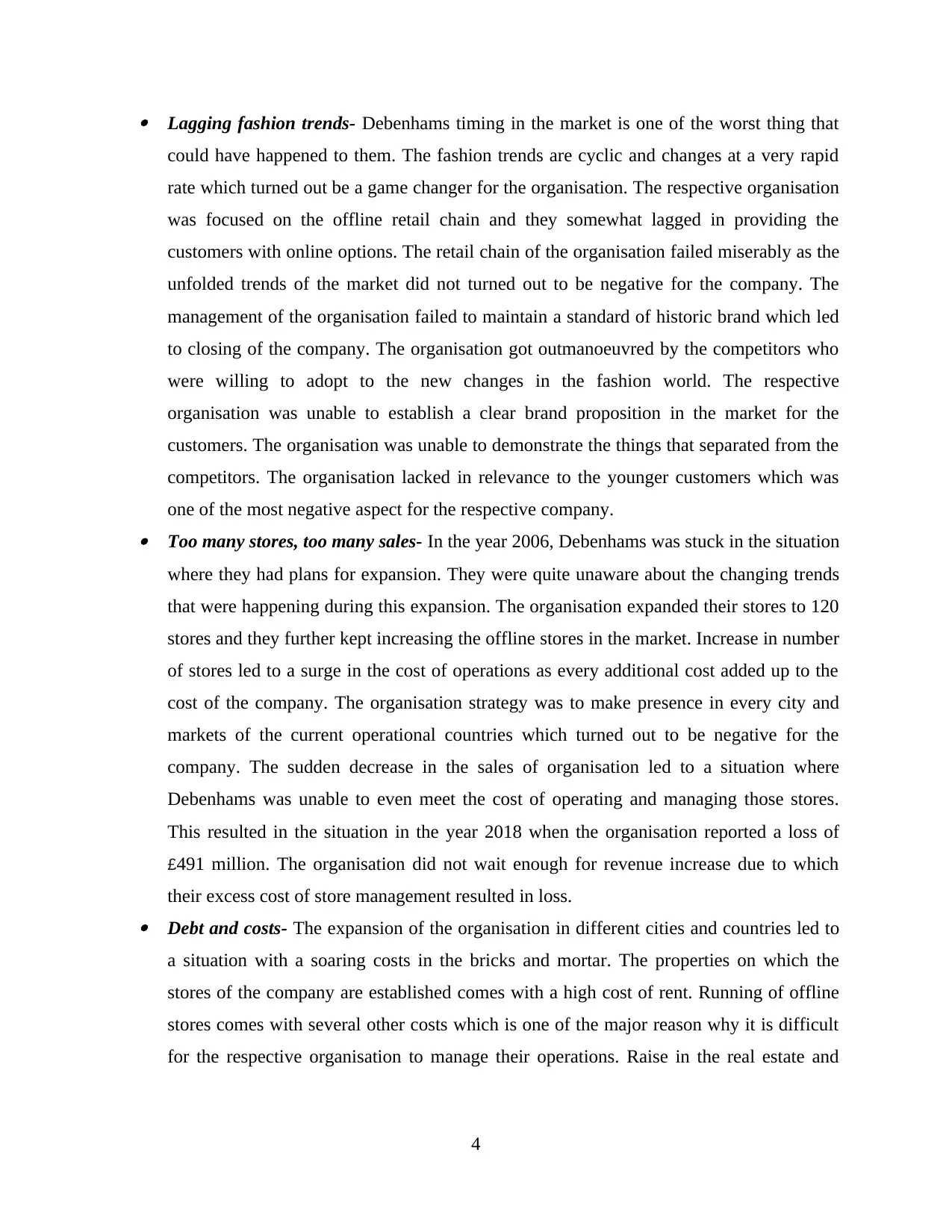
Lagging fashion trends- Debenhams timing in the market is one of the worst thing that
could have happened to them. The fashion trends are cyclic and changes at a very rapid
rate which turned out be a game changer for the organisation. The respective organisation
was focused on the offline retail chain and they somewhat lagged in providing the
customers with online options. The retail chain of the organisation failed miserably as the
unfolded trends of the market did not turned out to be negative for the company. The
management of the organisation failed to maintain a standard of historic brand which led
to closing of the company. The organisation got outmanoeuvred by the competitors who
were willing to adopt to the new changes in the fashion world. The respective
organisation was unable to establish a clear brand proposition in the market for the
customers. The organisation was unable to demonstrate the things that separated from the
competitors. The organisation lacked in relevance to the younger customers which was
one of the most negative aspect for the respective company. Too many stores, too many sales- In the year 2006, Debenhams was stuck in the situation
where they had plans for expansion. They were quite unaware about the changing trends
that were happening during this expansion. The organisation expanded their stores to 120
stores and they further kept increasing the offline stores in the market. Increase in number
of stores led to a surge in the cost of operations as every additional cost added up to the
cost of the company. The organisation strategy was to make presence in every city and
markets of the current operational countries which turned out to be negative for the
company. The sudden decrease in the sales of organisation led to a situation where
Debenhams was unable to even meet the cost of operating and managing those stores.
This resulted in the situation in the year 2018 when the organisation reported a loss of
£491 million. The organisation did not wait enough for revenue increase due to which
their excess cost of store management resulted in loss. Debt and costs- The expansion of the organisation in different cities and countries led to
a situation with a soaring costs in the bricks and mortar. The properties on which the
stores of the company are established comes with a high cost of rent. Running of offline
stores comes with several other costs which is one of the major reason why it is difficult
for the respective organisation to manage their operations. Raise in the real estate and
4
could have happened to them. The fashion trends are cyclic and changes at a very rapid
rate which turned out be a game changer for the organisation. The respective organisation
was focused on the offline retail chain and they somewhat lagged in providing the
customers with online options. The retail chain of the organisation failed miserably as the
unfolded trends of the market did not turned out to be negative for the company. The
management of the organisation failed to maintain a standard of historic brand which led
to closing of the company. The organisation got outmanoeuvred by the competitors who
were willing to adopt to the new changes in the fashion world. The respective
organisation was unable to establish a clear brand proposition in the market for the
customers. The organisation was unable to demonstrate the things that separated from the
competitors. The organisation lacked in relevance to the younger customers which was
one of the most negative aspect for the respective company. Too many stores, too many sales- In the year 2006, Debenhams was stuck in the situation
where they had plans for expansion. They were quite unaware about the changing trends
that were happening during this expansion. The organisation expanded their stores to 120
stores and they further kept increasing the offline stores in the market. Increase in number
of stores led to a surge in the cost of operations as every additional cost added up to the
cost of the company. The organisation strategy was to make presence in every city and
markets of the current operational countries which turned out to be negative for the
company. The sudden decrease in the sales of organisation led to a situation where
Debenhams was unable to even meet the cost of operating and managing those stores.
This resulted in the situation in the year 2018 when the organisation reported a loss of
£491 million. The organisation did not wait enough for revenue increase due to which
their excess cost of store management resulted in loss. Debt and costs- The expansion of the organisation in different cities and countries led to
a situation with a soaring costs in the bricks and mortar. The properties on which the
stores of the company are established comes with a high cost of rent. Running of offline
stores comes with several other costs which is one of the major reason why it is difficult
for the respective organisation to manage their operations. Raise in the real estate and
4
Secure Best Marks with AI Grader
Need help grading? Try our AI Grader for instant feedback on your assignments.
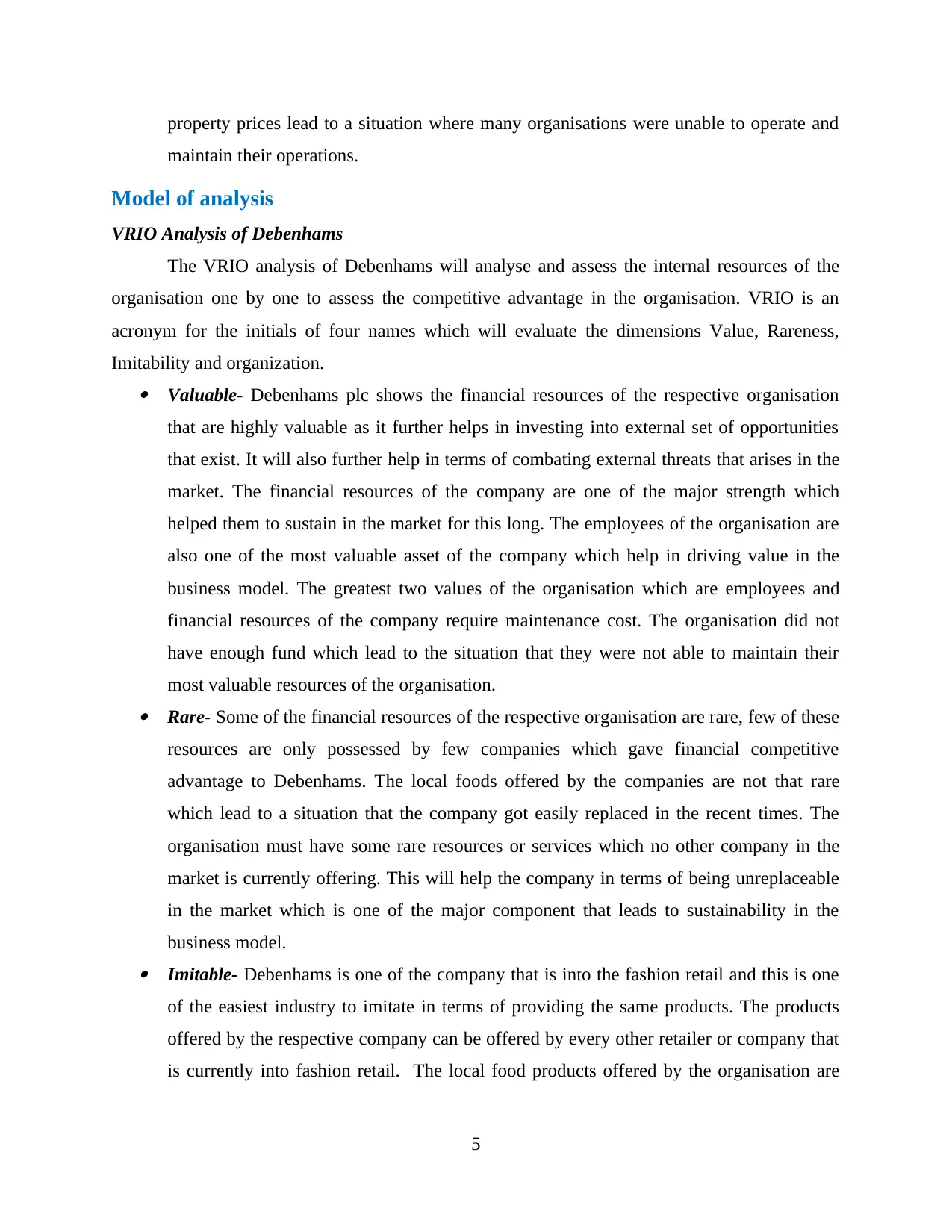
property prices lead to a situation where many organisations were unable to operate and
maintain their operations.
Model of analysis
VRIO Analysis of Debenhams
The VRIO analysis of Debenhams will analyse and assess the internal resources of the
organisation one by one to assess the competitive advantage in the organisation. VRIO is an
acronym for the initials of four names which will evaluate the dimensions Value, Rareness,
Imitability and organization. Valuable- Debenhams plc shows the financial resources of the respective organisation
that are highly valuable as it further helps in investing into external set of opportunities
that exist. It will also further help in terms of combating external threats that arises in the
market. The financial resources of the company are one of the major strength which
helped them to sustain in the market for this long. The employees of the organisation are
also one of the most valuable asset of the company which help in driving value in the
business model. The greatest two values of the organisation which are employees and
financial resources of the company require maintenance cost. The organisation did not
have enough fund which lead to the situation that they were not able to maintain their
most valuable resources of the organisation. Rare- Some of the financial resources of the respective organisation are rare, few of these
resources are only possessed by few companies which gave financial competitive
advantage to Debenhams. The local foods offered by the companies are not that rare
which lead to a situation that the company got easily replaced in the recent times. The
organisation must have some rare resources or services which no other company in the
market is currently offering. This will help the company in terms of being unreplaceable
in the market which is one of the major component that leads to sustainability in the
business model. Imitable- Debenhams is one of the company that is into the fashion retail and this is one
of the easiest industry to imitate in terms of providing the same products. The products
offered by the respective company can be offered by every other retailer or company that
is currently into fashion retail. The local food products offered by the organisation are
5
maintain their operations.
Model of analysis
VRIO Analysis of Debenhams
The VRIO analysis of Debenhams will analyse and assess the internal resources of the
organisation one by one to assess the competitive advantage in the organisation. VRIO is an
acronym for the initials of four names which will evaluate the dimensions Value, Rareness,
Imitability and organization. Valuable- Debenhams plc shows the financial resources of the respective organisation
that are highly valuable as it further helps in investing into external set of opportunities
that exist. It will also further help in terms of combating external threats that arises in the
market. The financial resources of the company are one of the major strength which
helped them to sustain in the market for this long. The employees of the organisation are
also one of the most valuable asset of the company which help in driving value in the
business model. The greatest two values of the organisation which are employees and
financial resources of the company require maintenance cost. The organisation did not
have enough fund which lead to the situation that they were not able to maintain their
most valuable resources of the organisation. Rare- Some of the financial resources of the respective organisation are rare, few of these
resources are only possessed by few companies which gave financial competitive
advantage to Debenhams. The local foods offered by the companies are not that rare
which lead to a situation that the company got easily replaced in the recent times. The
organisation must have some rare resources or services which no other company in the
market is currently offering. This will help the company in terms of being unreplaceable
in the market which is one of the major component that leads to sustainability in the
business model. Imitable- Debenhams is one of the company that is into the fashion retail and this is one
of the easiest industry to imitate in terms of providing the same products. The products
offered by the respective company can be offered by every other retailer or company that
is currently into fashion retail. The local food products offered by the organisation are
5
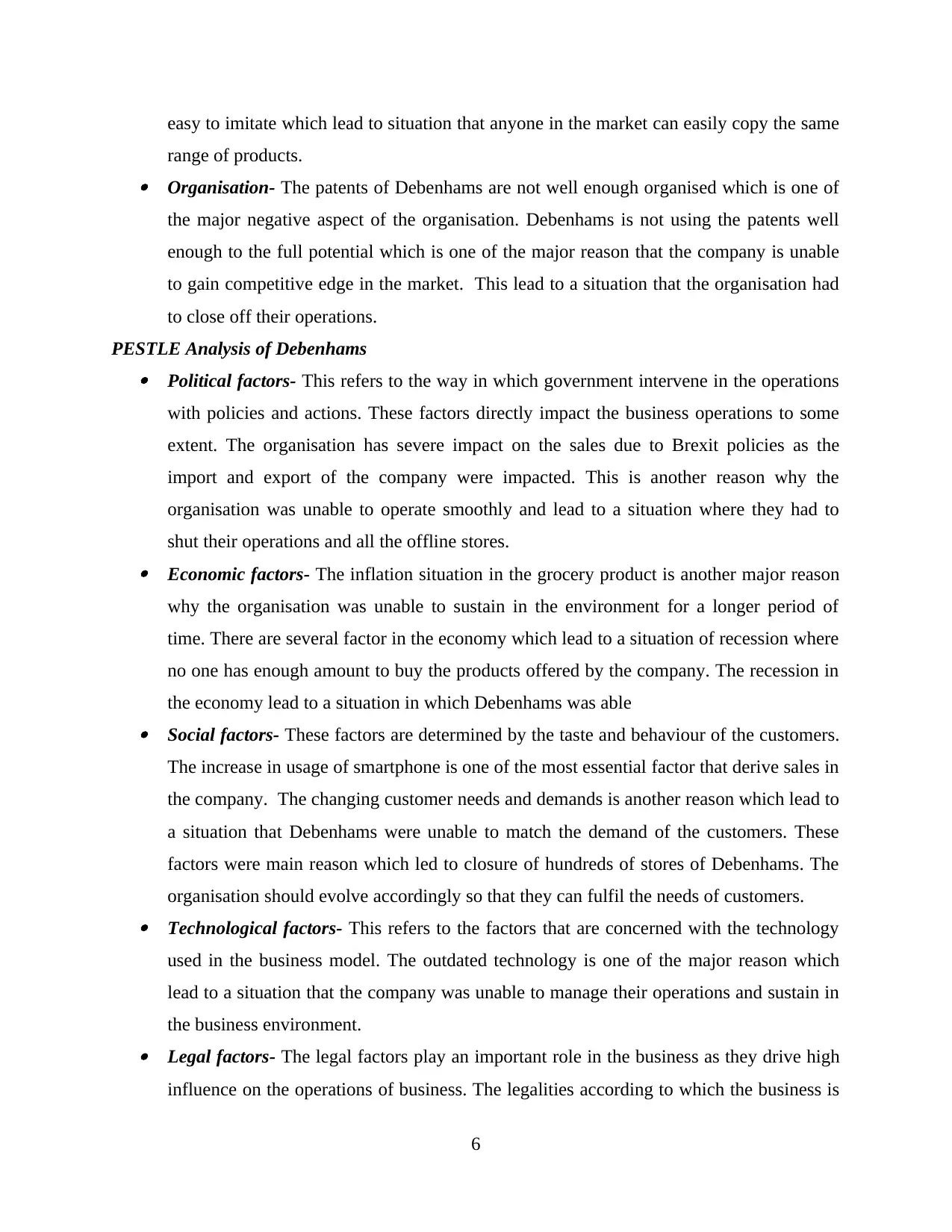
easy to imitate which lead to situation that anyone in the market can easily copy the same
range of products. Organisation- The patents of Debenhams are not well enough organised which is one of
the major negative aspect of the organisation. Debenhams is not using the patents well
enough to the full potential which is one of the major reason that the company is unable
to gain competitive edge in the market. This lead to a situation that the organisation had
to close off their operations.
PESTLE Analysis of Debenhams Political factors- This refers to the way in which government intervene in the operations
with policies and actions. These factors directly impact the business operations to some
extent. The organisation has severe impact on the sales due to Brexit policies as the
import and export of the company were impacted. This is another reason why the
organisation was unable to operate smoothly and lead to a situation where they had to
shut their operations and all the offline stores. Economic factors- The inflation situation in the grocery product is another major reason
why the organisation was unable to sustain in the environment for a longer period of
time. There are several factor in the economy which lead to a situation of recession where
no one has enough amount to buy the products offered by the company. The recession in
the economy lead to a situation in which Debenhams was able Social factors- These factors are determined by the taste and behaviour of the customers.
The increase in usage of smartphone is one of the most essential factor that derive sales in
the company. The changing customer needs and demands is another reason which lead to
a situation that Debenhams were unable to match the demand of the customers. These
factors were main reason which led to closure of hundreds of stores of Debenhams. The
organisation should evolve accordingly so that they can fulfil the needs of customers. Technological factors- This refers to the factors that are concerned with the technology
used in the business model. The outdated technology is one of the major reason which
lead to a situation that the company was unable to manage their operations and sustain in
the business environment. Legal factors- The legal factors play an important role in the business as they drive high
influence on the operations of business. The legalities according to which the business is
6
range of products. Organisation- The patents of Debenhams are not well enough organised which is one of
the major negative aspect of the organisation. Debenhams is not using the patents well
enough to the full potential which is one of the major reason that the company is unable
to gain competitive edge in the market. This lead to a situation that the organisation had
to close off their operations.
PESTLE Analysis of Debenhams Political factors- This refers to the way in which government intervene in the operations
with policies and actions. These factors directly impact the business operations to some
extent. The organisation has severe impact on the sales due to Brexit policies as the
import and export of the company were impacted. This is another reason why the
organisation was unable to operate smoothly and lead to a situation where they had to
shut their operations and all the offline stores. Economic factors- The inflation situation in the grocery product is another major reason
why the organisation was unable to sustain in the environment for a longer period of
time. There are several factor in the economy which lead to a situation of recession where
no one has enough amount to buy the products offered by the company. The recession in
the economy lead to a situation in which Debenhams was able Social factors- These factors are determined by the taste and behaviour of the customers.
The increase in usage of smartphone is one of the most essential factor that derive sales in
the company. The changing customer needs and demands is another reason which lead to
a situation that Debenhams were unable to match the demand of the customers. These
factors were main reason which led to closure of hundreds of stores of Debenhams. The
organisation should evolve accordingly so that they can fulfil the needs of customers. Technological factors- This refers to the factors that are concerned with the technology
used in the business model. The outdated technology is one of the major reason which
lead to a situation that the company was unable to manage their operations and sustain in
the business environment. Legal factors- The legal factors play an important role in the business as they drive high
influence on the operations of business. The legalities according to which the business is
6
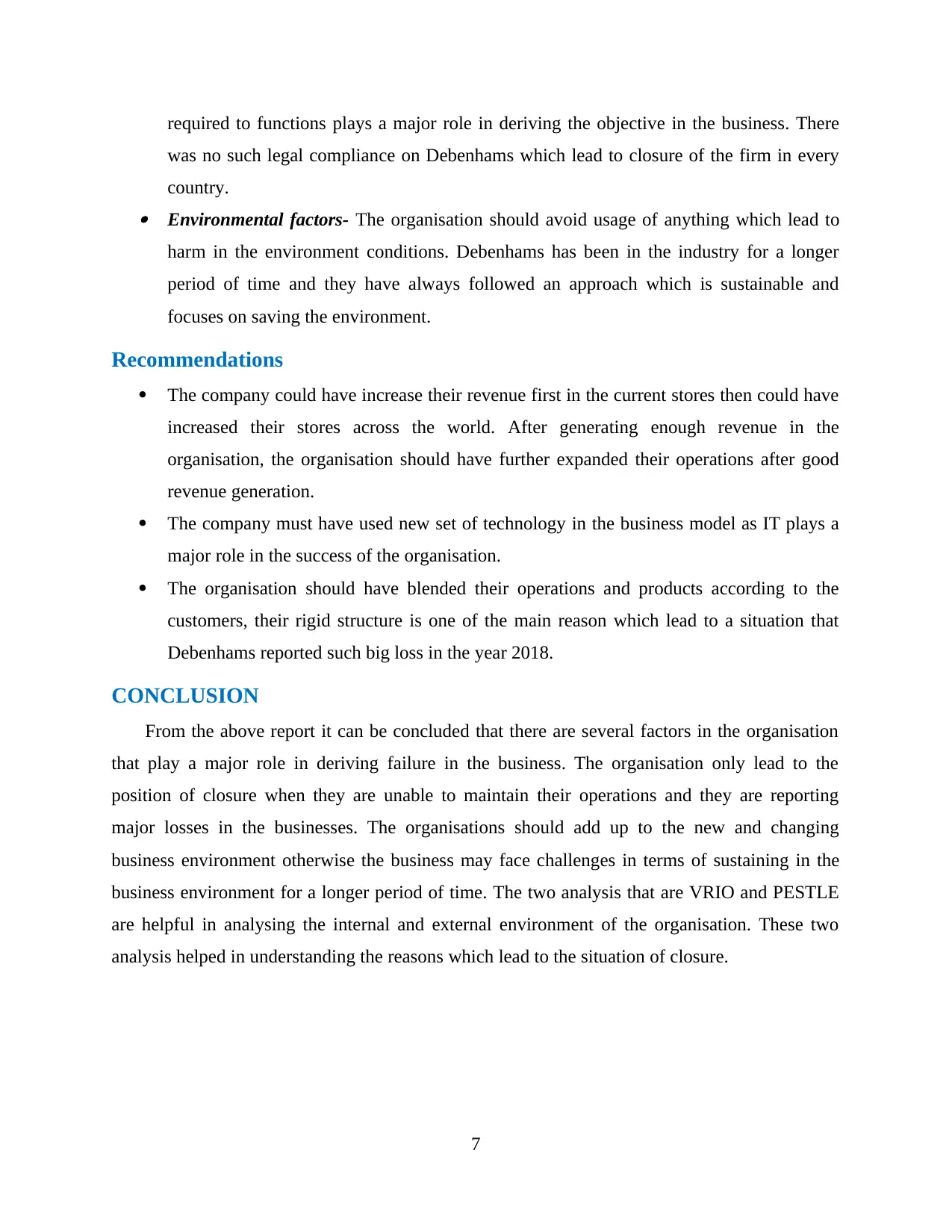
required to functions plays a major role in deriving the objective in the business. There
was no such legal compliance on Debenhams which lead to closure of the firm in every
country. Environmental factors- The organisation should avoid usage of anything which lead to
harm in the environment conditions. Debenhams has been in the industry for a longer
period of time and they have always followed an approach which is sustainable and
focuses on saving the environment.
Recommendations
The company could have increase their revenue first in the current stores then could have
increased their stores across the world. After generating enough revenue in the
organisation, the organisation should have further expanded their operations after good
revenue generation.
The company must have used new set of technology in the business model as IT plays a
major role in the success of the organisation.
The organisation should have blended their operations and products according to the
customers, their rigid structure is one of the main reason which lead to a situation that
Debenhams reported such big loss in the year 2018.
CONCLUSION
From the above report it can be concluded that there are several factors in the organisation
that play a major role in deriving failure in the business. The organisation only lead to the
position of closure when they are unable to maintain their operations and they are reporting
major losses in the businesses. The organisations should add up to the new and changing
business environment otherwise the business may face challenges in terms of sustaining in the
business environment for a longer period of time. The two analysis that are VRIO and PESTLE
are helpful in analysing the internal and external environment of the organisation. These two
analysis helped in understanding the reasons which lead to the situation of closure.
7
was no such legal compliance on Debenhams which lead to closure of the firm in every
country. Environmental factors- The organisation should avoid usage of anything which lead to
harm in the environment conditions. Debenhams has been in the industry for a longer
period of time and they have always followed an approach which is sustainable and
focuses on saving the environment.
Recommendations
The company could have increase their revenue first in the current stores then could have
increased their stores across the world. After generating enough revenue in the
organisation, the organisation should have further expanded their operations after good
revenue generation.
The company must have used new set of technology in the business model as IT plays a
major role in the success of the organisation.
The organisation should have blended their operations and products according to the
customers, their rigid structure is one of the main reason which lead to a situation that
Debenhams reported such big loss in the year 2018.
CONCLUSION
From the above report it can be concluded that there are several factors in the organisation
that play a major role in deriving failure in the business. The organisation only lead to the
position of closure when they are unable to maintain their operations and they are reporting
major losses in the businesses. The organisations should add up to the new and changing
business environment otherwise the business may face challenges in terms of sustaining in the
business environment for a longer period of time. The two analysis that are VRIO and PESTLE
are helpful in analysing the internal and external environment of the organisation. These two
analysis helped in understanding the reasons which lead to the situation of closure.
7
Paraphrase This Document
Need a fresh take? Get an instant paraphrase of this document with our AI Paraphraser

REFERENCES
Books and Journals
Bosnic, I. and Gasic, I., 2019. RIVER CRUISE INDUSTRY: TRENDS AND
CHALLENGES. Economic and Social Development: Book of Proceedings, pp.32-41.
Buchem, I., Klamma, R. and Wild, F. eds., 2019. Perspectives on Wearable Enhanced Learning
(WELL): Current Trends, Research, and Practice. Springer.
Di Silvestre, M. L. and et. al., 2020. Blockchain for power systems: Current trends and future
applications. Renewable and Sustainable Energy Reviews. 119. p.109585.
Dolega, L. and et. al., 2019. Beyond retail: New ways of classifying UK shopping and
consumption spaces. Environment and Planning B: Urban Analytics and City Science,
p.2399808319840666.
Efstratiadi, M. and et. al., 2019. Analysis of a closed-loop water-cooled refrigeration system in
the food retail industry: A UK case study. Energy. 174. pp.1133-1144.
Filimonau, V. and Mika, M., 2019. Return labour migration: an exploratory study of Polish
migrant workers from the UK hospitality industry. Current Issues in Tourism. 22(3).
pp.357-378.
Giri, C., Thomassey, S. and Zeng, X., 2019. Customer analytics in fashion retail industry.
In Functional Textiles and Clothing (pp. 349-361). Springer, Singapore.
Goff, P., 2020. Global trends in museum diplomacy: post-Guggenheim developments: by Natalia
Grincheva, Abingdon, UK, Routledge, 2020, 122 pp.,£ 45 (Hardback), ISBN 978-0-
8153-7094-9.
8
Books and Journals
Bosnic, I. and Gasic, I., 2019. RIVER CRUISE INDUSTRY: TRENDS AND
CHALLENGES. Economic and Social Development: Book of Proceedings, pp.32-41.
Buchem, I., Klamma, R. and Wild, F. eds., 2019. Perspectives on Wearable Enhanced Learning
(WELL): Current Trends, Research, and Practice. Springer.
Di Silvestre, M. L. and et. al., 2020. Blockchain for power systems: Current trends and future
applications. Renewable and Sustainable Energy Reviews. 119. p.109585.
Dolega, L. and et. al., 2019. Beyond retail: New ways of classifying UK shopping and
consumption spaces. Environment and Planning B: Urban Analytics and City Science,
p.2399808319840666.
Efstratiadi, M. and et. al., 2019. Analysis of a closed-loop water-cooled refrigeration system in
the food retail industry: A UK case study. Energy. 174. pp.1133-1144.
Filimonau, V. and Mika, M., 2019. Return labour migration: an exploratory study of Polish
migrant workers from the UK hospitality industry. Current Issues in Tourism. 22(3).
pp.357-378.
Giri, C., Thomassey, S. and Zeng, X., 2019. Customer analytics in fashion retail industry.
In Functional Textiles and Clothing (pp. 349-361). Springer, Singapore.
Goff, P., 2020. Global trends in museum diplomacy: post-Guggenheim developments: by Natalia
Grincheva, Abingdon, UK, Routledge, 2020, 122 pp.,£ 45 (Hardback), ISBN 978-0-
8153-7094-9.
8
1 out of 8
Related Documents
Your All-in-One AI-Powered Toolkit for Academic Success.
+13062052269
info@desklib.com
Available 24*7 on WhatsApp / Email
![[object Object]](/_next/static/media/star-bottom.7253800d.svg)
Unlock your academic potential
© 2024 | Zucol Services PVT LTD | All rights reserved.





